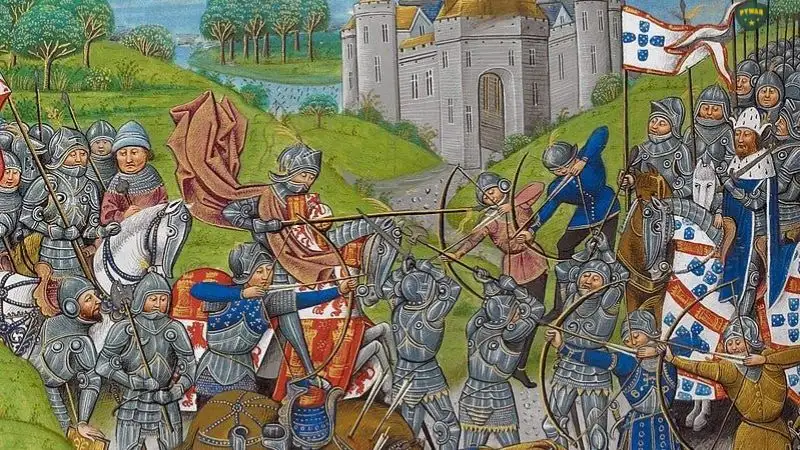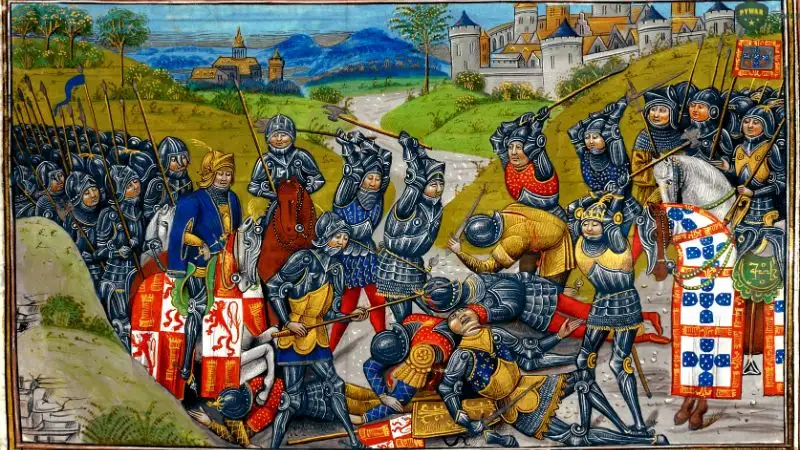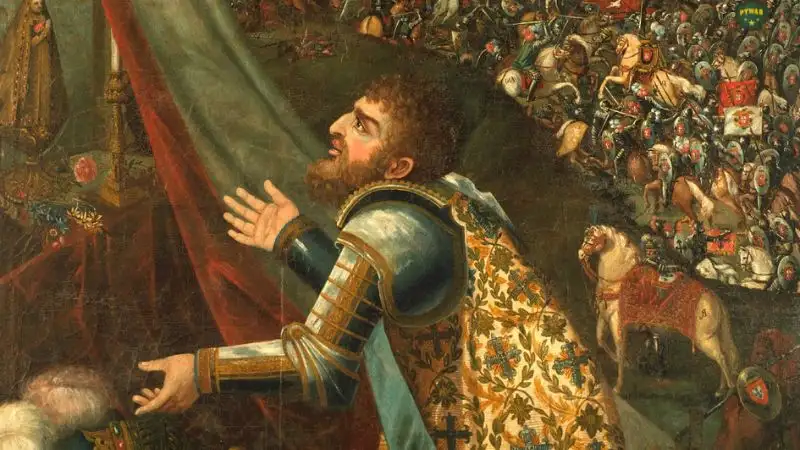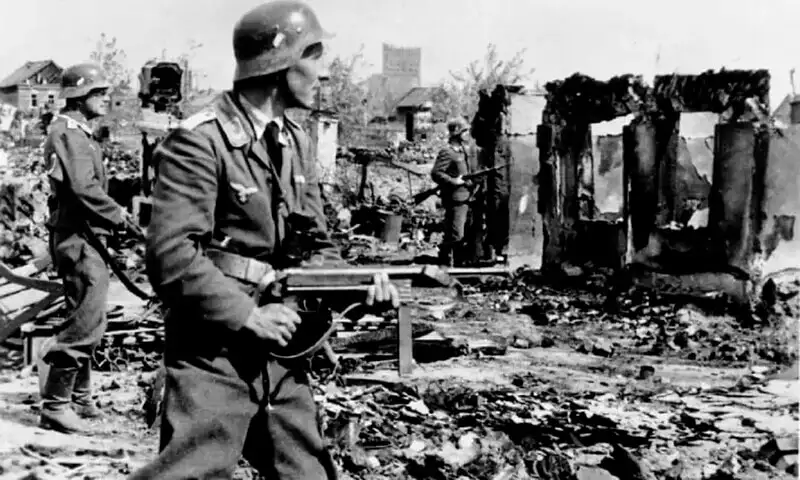The Battle of Aljubarrota, fought on August 14, 1385, stands as one of the most decisive moments in Portuguese history, securing the nation’s independence and establishing the House of Aviz dynasty. This clash between the Kingdom of Portugal and the Crown of Castile showcased innovative military tactics and the resilience of a smaller force against a numerically superior enemy. In this detailed exploration, we cover the time and date, location, causes, course, casualties, and victor of the Battle of Aljubarrota, offering a comprehensive look at this pivotal medieval conflict.
Time and Date of the Battle of Aljubarrota
The Battle of Aljubarrota took place in the late afternoon of August 14, 1385, coinciding with the eve of the Assumption of Mary, a significant religious date that added symbolic weight to the Portuguese victory. The battle, lasting roughly an hour, unfolded under intense midsummer heat, influencing the physical state of the combatants, particularly the Castilian forces, who were fatigued from their march.

Location of the Battle
The battle occurred on a small, flattened hill called São Jorge, near the town of Aljubarrota, between Leiria and Alcobaça in central Portugal, approximately 80 miles north of Lisbon. This strategic location, chosen by Portuguese general Nuno Álvares Pereira, featured natural defenses, including creeks and steep terrain, ideal for the defensive tactics employed. The battlefield’s widest point, known as Chão da Feira (Fair’s Ground), remains preserved today, with the nearby Battle of Aljubarrota Interpretation Centre offering insights into the conflict. The site’s proximity to the Leiria-Lisbon road made it a critical interception point for the invading Castilian army.
Causes of the Battle of Aljubarrota
The Battle of Aljubarrota was the culmination of the 1383–1385 Portuguese Interregnum, a period of political crisis following the death of King Fernando I in 1383 without a male heir. The roots of the conflict lay in dynastic disputes and fears of Castilian domination over Portugal, exacerbated by deteriorating living conditions and popular discontent.
Fernando I’s daughter, Beatriz, was married to King John I of Castile in 1383, with an agreement that their eldest child would inherit the Portuguese throne, and Fernando’s widow, Leonor Teles, would act as regent. However, Beatriz had no children by 1383, and Leonor’s regency, coupled with her pro-Castilian policies, alarmed Portuguese nobles and the bourgeoisie, who feared annexation by Castile. This prospect sparked widespread unrest, particularly in Lisbon, where the population proclaimed John of Aviz, Fernando’s illegitimate half-brother and Master of the Order of Aviz, as “regent and defender” of the kingdom in 1383.
John of Aviz led a popular uprising against Leonor and her Castilian allies, triggering Castilian invasions in 1384 and 1385 to enforce Beatriz’s claim. A Castilian siege of Lisbon in 1384 failed due to plague and supply shortages, partly caused by Nuno Álvares Pereira’s guerrilla tactics. By April 1385, the Portuguese Cortes in Coimbra declared John of Aviz King John I, rejecting Castilian rule. In response, King John I of Castile launched a major invasion in July 1385 with a large army, aiming to crush the rebellion and secure the Portuguese throne. The convergence of these dynastic, political, and nationalistic tensions set the stage for the Battle of Aljubarrota.
Course of the Battle
The Battle of Aljubarrota was a masterclass in defensive tactics, leveraging terrain, preparation, and allied support to overcome a larger force. Below is a detailed account of its progression, drawing from historical sources and modern analyses.
Prelude to Battle
By July 1385, King John I of Castile advanced toward Lisbon with an army of approximately 20,000–40,000 men, including Portuguese legitimists loyal to Beatriz, Aragonese and Genoese mercenaries, and a contingent of 2,000 French knights sent by Charles VI. This force, bolstered by 16 cannons, represented a formidable medieval army. In contrast, the Portuguese army, led by King John I and Constable Nuno Álvares Pereira, numbered around 7,000, including 200 English longbowmen and 500 Anglo-Gascon men-at-arms, veterans of the Hundred Years’ War, sent under the Anglo-Portuguese Treaty of 1373.
Nuno Álvares Pereira, a brilliant strategist at age 25, selected the São Jorge hill for its defensive advantages: creeks and steep slopes protected the flanks, and a gentle rear slope allowed for a fortified position. On August 6, a war council in Abrantes confirmed the decision to intercept the Castilians rather than retreat to Lisbon. The Portuguese army, after hearing mass at Porto de Mós, took position on the hill’s north side by 10 a.m. on August 14, facing the Roman road from which the Castilians approached.

The Portuguese fortified their position with trenches, brushwork palisades, and “covas-de-lobo” (wolf pits)—hidden holes designed to trip horses. Their formation followed English defensive tactics seen at Crécy and Poitiers: dismounted men-at-arms and infantry formed a central square, with archers on the flanks and a small cavalry reserve at the rear. This setup aimed to neutralize the Castilian cavalry’s advantage.
The Battle Unfolds
The Castilian army, exhausted from marching under the August sun, arrived by late morning. Recognizing the steep frontal slope’s danger, John I of Castile opted to attack the Portuguese rearguard, which appeared weaker on gentler terrain. This required a lengthy maneuver to reposition his forces, further tiring his troops and delaying the assault until late afternoon.
As the Castilians deployed their cannons, a novel but imprecise weapon, the Portuguese held firm despite the psychological impact of the artillery. The Castilian light cavalry attempted to probe the Portuguese rear, but the fortified defenses and terrain limited their effectiveness. Around 4 p.m., the main Castilian assault began, led by French knights and Castilian men-at-arms, targeting the Portuguese square.
The Portuguese defenses proved formidable. The wolf pits disrupted cavalry charges, causing horses to stumble and exposing riders to English longbow volleys from the flanks. The dismounted Portuguese infantry, supported by crossbowmen, repelled the frontal assault, maintaining their square formation. As the Castilian standard fell during the melee, panic spread through their ranks, exacerbated by the intense heat and lack of cohesion.
The Decisive Moment
The Portuguese wings, including the English archers, launched a counterattack from the flanks, enveloping the disorganized Castilian forces. The Castilian army disintegrated, with many soldiers fleeing toward Leiria. Local Portuguese civilians, fueled by anti-Castilian sentiment, pursued and killed fleeing troops, amplifying the rout. King John I of Castile escaped by sea to Seville, abandoning his campaign.
The battle, lasting just over an hour, showcased the effectiveness of defensive tactics and terrain exploitation, drawing parallels to English victories in the Hundred Years’ War. The Portuguese victory was decisive, ending Castilian ambitions in Portugal.
Casualties of the Battle
Casualty estimates vary due to the biases of medieval chroniclers like Fernão Lopes and Pero López de Ayala. The Portuguese suffered approximately 1,000 casualties, a significant but manageable loss for their smaller force. The Castilians, however, faced devastating losses, with estimates of 4,000 killed in the battle and an additional 5,000 wounded or slain by civilians during their retreat. The high Castilian casualties, including many Portuguese legitimists, weakened John I of Castile’s political and military influence, while the survival of key Portuguese leaders like Nuno Álvares Pereira ensured continued resistance.
Who Emerged Victorious?
The Kingdom of Portugal, under King John I and Nuno Álvares Pereira, emerged decisively victorious at the Battle of Aljubarrota. This triumph ended the 1383–1385 crisis, confirmed John I as the uncontested king, and established the House of Aviz as Portugal’s ruling dynasty. The victory safeguarded Portuguese independence, thwarting Castilian annexation until the 1580 crisis two centuries later. It also strengthened the Anglo-Portuguese alliance, formalized by the Treaty of Windsor in 1386 and sealed by John I’s marriage to Philippa of Lancaster in 1387.

Significance and Legacy
The Battle of Aljubarrota was a defining moment in Portuguese history, consolidating national identity and paving the way for the Age of Discoveries. Nuno Álvares Pereira’s tactical innovations, including the use of fortifications and dismounted infantry, influenced medieval warfare, while the English longbowmen’s role underscored the value of allied support. King John I’s vow to build a monastery if victorious led to the construction of the Monastery of Batalha, a UNESCO World Heritage Site and a testament to the battle’s enduring legacy.
The battlefield, now a National Monument, is preserved by the Battle of Aljubarrota Foundation, with the Interpretation Centre offering artifacts and multimedia displays. The victory is commemorated annually, reflecting Portugal’s pride in its independence and resilience. Aljubarrota remains a symbol of strategic brilliance and national unity, shaping Portugal’s trajectory as a maritime power.
Sources
- Polybius, Histories, Book 3
- Livy, The History of Rome
- Froissart, Jean. Chronicles.
- Monteiro, João Gouveia. “The Battle of Aljubarrota (1385): A Reassessment.” Journal of Medieval Military History, 2009.
- Fundação Batalha de Aljubarrota.




